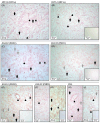Dynamic Regulation of HIF1α and Oxygen-Sensing Factors in Cyclic Bovine Corpus Luteum and During LPS Challenge
- PMID: 40003076
- PMCID: PMC11851762
- DOI: 10.3390/ani15040595
Dynamic Regulation of HIF1α and Oxygen-Sensing Factors in Cyclic Bovine Corpus Luteum and During LPS Challenge
Abstract
Understanding the corpus luteum (CL) and its role in cattle reproduction is crucial, particularly as it is a progesterone source for the establishment and maintenance of pregnancy. Reduced oxygen levels significantly impact these processes. This study investigated the effects of the luteal stage on the spatio-temporal gene expression patterns of HIF1α and oxygen-sensing factors, as well as the impact of lipopolysaccharide (LPS)-induced inflammation on these factors. Endothelial inflammatory responses were also addressed. The samples included CL collected at the early, mid, and late stages, as well as biopsies from mid-luteal stage cows treated either with saline (controls) or LPS. Samples collected in subsequent cycles assessed potential carryover effects. RT-PCR revealed upregulation of HIF1α, PHD1, PHD3, FIH, and VHL encoding genes in the mid-luteal stage. In situ hybridization revealed the compartmentalization of HIF1α and its regulators within the luteal and endothelial cells, suggesting their cell-specific roles. LPS treatment affected PHD1 and PHD3 expression, while increasing endothelial pro-inflammatory factors ICAM1 and NFκB, suggesting vascular inflammation and modulated oxygen sensing. These findings reveal new insights into the spatio-temporal expression of HIF1α-regulating factors in the CL, highlighting their potential role in controlling luteal function, detailing their cellular compartmentalization, and the effects of LPS-mediated inflammatory responses.
Keywords: HIF1α; LPS; bovine corpus luteum; hypoxia.
Conflict of interest statement
The authors declare no conflicts of interest.
Figures





Similar articles
-
LPS-mediated effects and spatio-temporal expression of TLR2 and TLR4 in the bovine corpus luteum.Reproduction. 2016 Apr;151(4):391-9. doi: 10.1530/REP-15-0520. Epub 2016 Jan 13. Reproduction. 2016. PMID: 26762400
-
Intramammary lipopolysaccharide infusion alters gene expression but does not induce lysis of the bovine corpus luteum.J Dairy Sci. 2016 May;99(5):4018-4031. doi: 10.3168/jds.2015-10641. Epub 2016 Feb 28. J Dairy Sci. 2016. PMID: 26923046
-
Regulation of cellular communication network factor 1 by Ras homolog family member A in bovine steroidogenic luteal cells.J Anim Sci. 2022 Jul 1;100(7):skac124. doi: 10.1093/jas/skac124. J Anim Sci. 2022. PMID: 35772754 Free PMC article.
-
Regulation of corpus luteum function in cattle--an overview.Reprod Domest Anim. 2004 Aug;39(4):241-51. doi: 10.1111/j.1439-0531.2004.00509.x. Reprod Domest Anim. 2004. PMID: 15225277 Review.
-
Inter- and intra-cellular mechanisms of prostaglandin F2alpha action during corpus luteum regression in cattle.Soc Reprod Fertil Suppl. 2010;67:305-24. doi: 10.7313/upo9781907284991.025. Soc Reprod Fertil Suppl. 2010. PMID: 21755681 Review.
Cited by
-
Vasohibins in Health and Disease: From Angiogenesis to Tumorigenesis, Multiorgan Dysfunction, and Brain-Heart Remodeling.Cells. 2025 May 23;14(11):767. doi: 10.3390/cells14110767. Cells. 2025. PMID: 40497943 Free PMC article. Review.
References
Grants and funding
LinkOut - more resources
Full Text Sources
Miscellaneous

